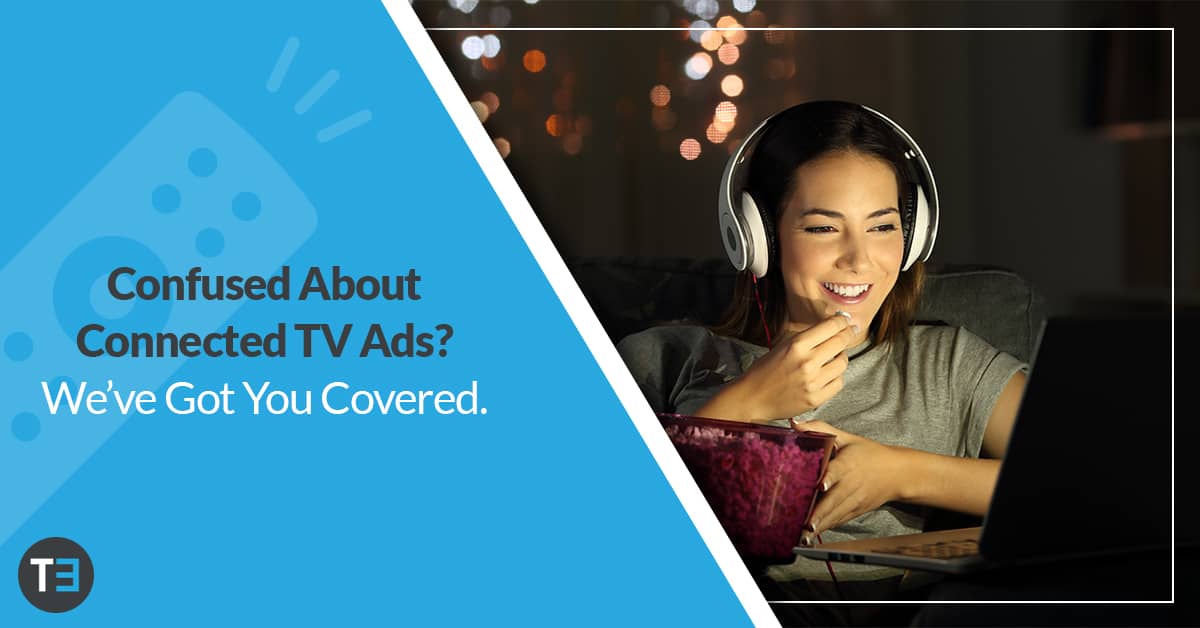Connected TV Ads: Know Before You Buy
6 Minute Read
Advertising on connected TV (CTV) represents an exciting opportunity for increasing the brand recognition of your business. However, there are important nuances and limitations to be aware of before you invest in this advertising strategy.
Connected TV refers to televisions and other devices connected to the Internet. It is part of a content distribution and consumption model known as over-the-top (OTT), which encompasses all types of streaming digital video.
As with other forms of digital advertising, CTV offers targeting options, engagement opportunities, and data-driven insights many times beyond what you can get with old-fashioned advertising on television. But don’t be fooled by the buzzwords: Connected TV should be treated as a component of a comprehensive media strategy, not the only option for growing your business.
Is CTV the Same as OTT?
Many advertisers and agencies use the terms “over the top” and “connected TV” as though they are interchangeable. This is misleading.
CTV supports ads delivered on a wide range of devices, including:
- Smart TVs
- Internet-enabled TVs
- Streaming set-top boxes and sticks (e.g., Roku, Amazon Fire TV Stick, etc.)
- Gaming consoles with Internet connection
- DVD and Blu-ray players with Internet capabilities
Meanwhile, OTT refers more generally to the streaming video consumed outside of traditional television broadcasting. (“Over-the-top” programming is distributed outside of (or “over”) the normal TV airwaves.)
The Interactive Advertising Bureau says it best: “CTV initiatives focus on video that is internet delivered, and viewed on a (big screen) TV.” OTT advertising strategies are much broader because they encompass audiences who may consume digital video outside of Internet-connected televisions. If you are discussing CTV and OTT with an ad rep or marketing agency, it is important to keep this distinction in mind.

Who Watches Connected TV?
Knowing your audience is essential for the success of any digital advertising campaign. Connected TV has seen a massive increase in viewership over the years, growing by 24 million users in 2020 alone. Usage of CTV transcends the all-important age demographic, encompassing everyone from young adults to retirees.
Connected TV represents an irresistible opportunity to deliver ads to a wide-ranging and engaged audience. However, CTV viewers differ in at least one important respect from those who consume digital video through other OTT platforms (such as YouTube).
Viewing Habit Differences: CTV vs. OTT
The devices that make up the connected TV landscape are designed to mimic the experience of watching television the way it has been for nearly a century. Viewers are able to sit back, relax, and watch a variety of programs. Connected TV ads are unskippable, which means the viewer will see the entirety of your video ad. However, they also have no way to engage with the ad, such as clicking to your website.
Now compare how people watch videos on YouTube and other OTT platforms. These users will skip ads when they can, but they also have the ability to interact with the ad (and, by extension, the brand behind it) if the messaging speaks to them and they have the need for the product or service.
This makes an enormous difference in defining the success of an advertising campaign on connected TV. If your goal is to build brand awareness, CTV advertising is great because viewers have to watch the entire ad. For conversions, however, you may be better suited running other OTT campaigns (like Google Display Network ads) so users can go straight from the video ad to your website or lead generation form.
Unfortunately, agencies and vendors sometimes gloss over this very important difference. Before being sucked in by the “cool factor” and immense reach of connected TV, it is crucial to make sure this advertising strategy meets your needs and goals.

Who Controls Connected TV Ads?
Virtually all digital advertising strategies involve one or more third parties. The Google Display Network, for instance, is the platform that enables advertisers and agencies to position video ads on YouTube and other highly visible websites your customers may use.
The powers that be in connected TV are not always so easy to identify. Some connected TV ads are sold directly by providers like Hulu and Amazon. In other cases you may buy CTV ads programmatically. You may also deal with specific TV networks or media giants like Comcast, which sell connected TV ads in addition to linear TV buys.
Budgeting for Connected TV Ads
Navigating the multiple layers of purchases and interactions on your own can be very difficult. The number of “touches” involved also tends to drive up the cost per mille (CPM, or cost per thousand impressions).
The CPM on connected TV ads can be up to five times higher than the CPM on Google Display Network campaigns. As a result, you may find that advertising to multiple connected TV audiences on different services or platforms puts a strain on your advertising budget.
If you’re working with a company, you need to know where your ad inventory is coming from to know if the CPM is appropriate. OTT CPMs are less expensive than the CPM for connected TV ads. So, if the third-party CPM seems low, this is an indication that you are not getting the premium ad inventory.
Most businesses find it helpful to partner with a reputable ad agency to help them target the right audience and run ads where they are likely to make the biggest impact. Experience and trust are two musts when hiring an agency to handle your digital advertising.
How Are Connected TV Ads Sold?
One of the major selling points of connected TV advertising is the ability to show up to viewers who watch the “hottest” programs on major streaming services like Hulu, Amazon, etc. This is akin to the primetime slots in traditional TV advertising, where the most popular shows are the most coveted by advertisers.
Broadly speaking, digital video can be divided into two different categories. Most people associate connected TV with long-form content, such as shows and movies. However, your same ad may also appear in front of short-form videos (defined by the Interactive Advertising Bureau as a video with a “duration of less than 8 minutes”) viewed on CTV devices.
Short-form videos are part of the OTT realm (they are digital videos). However, only the loosest definition of connected TV would include brief video clips (like news stories, sports highlights, how-to videos, etc.).
When agencies and providers treat CTV and OTT advertising as the same thing, this creates confusion around how connected TV ads are sold. Conflating the two can also skew the data in individual advertising campaigns, making it seem like connected TV ads reach a wider audience than they actually do.

Reaching the Right Audience with Connected TV Ads
Ads on connected TV are more effective for catering to potential customers who are very early in the sales funnel. Some of the viewers you reach through CTV and OTT may not even realize they have a need for your services.
Engaging this audience early can pay dividends at a later date when they are ready to buy. However, if your goal is lead generation, you may be disappointed by the results of a connected TV advertising campaign.
The principle metric for measuring the reach of a connected TV ad is impressions. Impressions refer to the number of people who see an ad, not the number of people who act on it.
Monthly reports on CTV ad campaigns identify the number of impressions, not exactly where and when your ads run (beyond highly general categories, such as “News” and “Sports”). Tracking the performance of CTV ads is challenging since there is no clickable link. Unless the ad has a specific call-to-action, like a special phone number or offer code, it will be hard to know the true impact of your campaign.
Is Connected TV Right for Me?
Today’s digital advertising has many different options for brands to reach customers and drive more business. Diversity of campaigns is key for maximizing your visibility and conversions.
Before you invest in a connected TV and/or OTT advertising strategy, it is important to identify your goals and determine how these channels will help you reach them. As the campaigns are implemented, you need to be able to trust your agency to provide transparent and accurate reporting so you can make adjustments and maximize your ROI.
The paid media team at Twelve Three Media has extensive experience buying ads and managing campaigns for businesses in a wide range of industries. We succeed when you succeed, which means we take the time and effort to identify the most valuable advertising channels and develop ads that help you stand out and generate more revenue.
Need help with ads for CTV, OTT, and other types of digital advertising? Talk to the team at Twelve Three Media to find out how we can give you the unfair marketing advantage!
